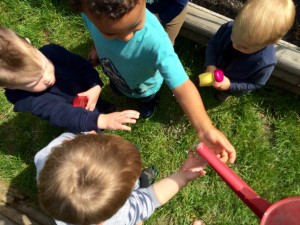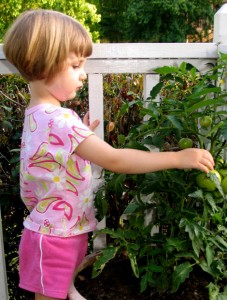Kids and gardens are both growing so it’s quite natural for them to be together. A garden is not a wild place but usually carefully planned and tended. Gardens to not need to be huge spaces, they can be as small as a few pots on a deck or balcony. Whatever size the spot, it’s excellent for experiencing and connecting to nature.
 Seeds aren’t the only thing that grows in a garden so does children’s awareness of their senses. Gardens are definitely hands-on. Hands get to dig in the soil, pour water from a watering can, feel slippery earthworms and fuzzy caterpillars, pull up weeds, and gently touch the plants. Whole bodies get to feel the warm sun and cool shade.
Seeds aren’t the only thing that grows in a garden so does children’s awareness of their senses. Gardens are definitely hands-on. Hands get to dig in the soil, pour water from a watering can, feel slippery earthworms and fuzzy caterpillars, pull up weeds, and gently touch the plants. Whole bodies get to feel the warm sun and cool shade.
Not only is there lots to touch, there are many things to see. There are so many different sorts of just the color green: pale, like new tomatoes and deep, like zucchinis. All the colors make a rainbow in the garden. There’s a never-ending variety of shapes, lines, sizes, and patterns. The light dances among the leaves. Tiny movements hint at the location of little creatures but sometimes they are almost too fast for eyes.
 From the smell of the soil, to the perfume of flowers. kids explore all the scents and odors in a garden. Before vegetables are ready, kids are exploring how things taste. Gardens are also full of sounds as the wind rustles the leaves and feet scrunch on rocky paths. Birds might sing along.
From the smell of the soil, to the perfume of flowers. kids explore all the scents and odors in a garden. Before vegetables are ready, kids are exploring how things taste. Gardens are also full of sounds as the wind rustles the leaves and feet scrunch on rocky paths. Birds might sing along.
Children use their senses to learn about the world around them and their own inner one. Nature teaches many other lessons such as patience, order, responsibility, and more. Kids get to experience basic natural science. For instance, life-cycles, the importance of water and light, and more. Gardens do not just include plants, but insects too.
Kids who are involved in gardening develop a partnership with nature. They begin to understand how to care for nature’s gifts and how to care for themselves. Does your child have a garden?
(Have you seen some of the resources growing in 123’s garten?)
